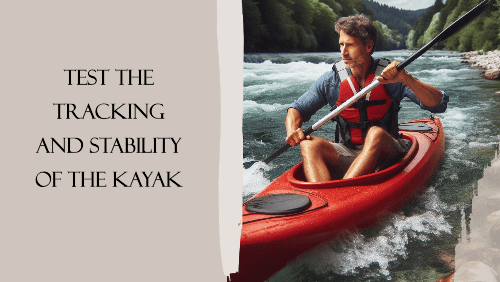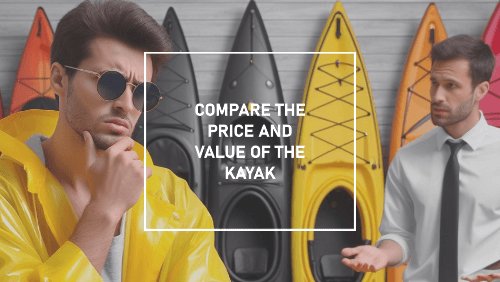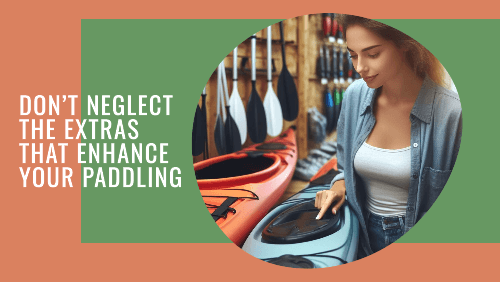Kayaking doesn’t have to drain your wallet. Buying a used kayak is a budget-friendly way to hit the water without sacrificing quality. But a good deal isn’t just about the price—it’s about choosing a kayak that suits your needs. Whether you’re a beginner or an experienced paddler, knowing what to look for ensures you get the best value.
Choose A Kayak Based On Your Paddling Style

When I’m choosing a kayak, I consider what type of paddling I’ll be doing most. Recreational kayaks are usually where I point beginners due to their wide, stable build – perfect for those leisurely trips on calm waters.
But if I plan on longer voyages, then a touring kayak, which is narrower and comes with hatches for storage, is what I steer towards.
Speed enthusiasts like me are often drawn to racing and training kayaks. Their sleek design and lightweight materials cut through the water with less effort, but they’re not the best choice for a novice. Stability is compromised for speed, a trade-off to consider based on your experience.
Consider The Size And Shape Of The Kayak

The size and shape of the kayak will dictate how it performs on the water. Wider kayaks offer more stability, a feature I appreciate when I’m fishing or taking photos.
Longer kayaks, on the other hand, tend to track straighter and handle choppy conditions better. So, my advice is to think about where you’ll be paddling and choose a kayak that matches those conditions.
Align Your Choice With Your Skill Level

Remember to align your choice with your skill level. It’s tempting to go for that sleek, high-end model, but if it’s more kayak than you can handle, you won’t enjoy it. And when you’re spending money – even on a used one – enjoyment is key.
Inspecting a Preowned Kayak: Beyond First Impressions
I put great emphasis on the inspection process when buying a used kayak. It’s like playing detective – you’re looking for clues that tell the true story of the kayak’s past.
Check The Overall Condition Of The Kayak

You need to start with a visual once-over, keeping an eye out for any noticeable frayed ropes and checking whether the kayak is clean; these can be indicators of how well it was maintained.
Examine The Hull For Any Damage

Then, it’s time to get hands-on. Feel the hull of the kayak. Deformities, dents, cracks, or deep gouges may suggest past collisions or poor handling that could compromise the integrity and safety of the boat. Pay special attention to the UV damage, as this can weaken the plastic over time.
Inspect The Cockpit Outfitting And Compartments

Make sure you inspect the cockpit outfitting. Are the seats, foot pegs, and back bands in good shape?
These elements are essential for comfort and control while on the water. Peek into the hatches and bulkheads—these compartments should be dry and well-sealed to safeguard your gear during paddling expeditions.
A quick check of the hull shape for symmetry can also provide insight into whether the kayak has been properly stored or if it has suffered from warping.
Make An Informed Decision

The results of this forensic level of scrutiny? You know what you’re dealing with. If the kayak has minor issues, you can decide whether you’re willing to fix them or negotiate the price accordingly.
If there are major red flags, you might decide that this particular kayak isn’t the one for you. After all, it’s not just about getting a kayak; it’s about investing in your safety and enjoyment on the water.
A Paddler’s Test Drive: Ensuring a Sea-worthy Investment
It might look great on land, but the true test of a kayak’s worth is how it performs on water. Before handing over any money, insist on a test paddle. This isn’t just about ensuring you’re not buying a dud; it’s about feeling the connection between you and your potential new vessel. Here’s what to keep an eye out for.
Assess The Comfort And Fit Of The Kayak

First and foremost, take a seat and get a genuine feel for the comfort. You’ll spend hours in this kayak, so if it doesn’t feel right in the first five minutes, it probably never will.
Remember to adjust the foot pegs and backrest to suit your frame, as this can significantly affect your overall comfort.
Test The Tracking And Stability Of The Kayak

Once situated, push off and pay attention to the kayak’s tracking, or its ability to maintain a straight line while paddling.
If it seems to have a mind of its own, it could be a sign of an uneven hull or other issues. A kayak that veers off course will make for a strenuous and frustrating paddling experience.
Look And Listen For Leaks In The Kayak

Look and listen for leaks. It’s not uncommon for older kayaks to take on water, but you need to know where and how much. Small leaks might be repairable, but larger ones could signal a kayak’s demise.
Check The Responsiveness Of The Skeg Or Rudder

Check how responsive the skeg or rudder is. Are you able to maneuver easily or does it feel like a struggle? The condition of these parts often indicates how well the previous owner maintained the kayak.
Evaluate The Maneuverability Of The Kayak

Finally, consider the kayak’s maneuverability. Paddle through a variety of motions and turns to assess how it handles. A kayak that’s difficult to steer won’t just dampen the fun; it might also compromise your safety in challenging conditions.
Make An Informed Decision
Remember, issues discovered during a test paddle can often be used as bargaining chips in negotiating the price.
A small investment in repairs can sometimes transform a second-hand kayak bargain into a prized possession. However, factor in these potential costs and the effort required to fix them.
Navigating the Purchase: Cost, Accessories, and Locations
Understanding the financials is key when you’re on the hunt for a used kayak. You’ll want to avoid overspending, but remember, the right fit and suitability for your needs trump a lower price tag. Kayaks are sturdy – they tend to hold their value well over time.
Compare The Price And Value Of The Kayak

Take a look at the kayak’s age, any issues I’ve previously discussed, and how comfortable the kayak feels. Your well-being on the water is PRICELESS.
Don’t Neglect The Extras That Enhance Your Paddling

Don’t forget the extras – from rudders and skegs to deck rigging and hatches. Ensure they’re in good shape and replacements are accessible if needed. These accessories can make a significant difference in your kayaking experience.
Explore Different Shopping Locations And Options
When it comes to shopping locations, broaden your horizons. Local paddling shops offer expert advice and a curated selection.
Don’t overlook garage sales or classified ads – they can be treasure troves for great deals. For the digitally inclined, platforms like Facebook Marketplace and eBay are invaluable for a wider range of choices, but always prioritize seeing the kayak firsthand before making a decision.
Enjoy The Benefits Of Buying A Used Kayak
Used kayaks present a world of adventures waiting to be unlocked. Remember, a little research and patience go a long way towards ensuring your days on the water are safe, enjoyable, and within budget. Dive into the kayak community, ask questions, and let your experiences guide others.
